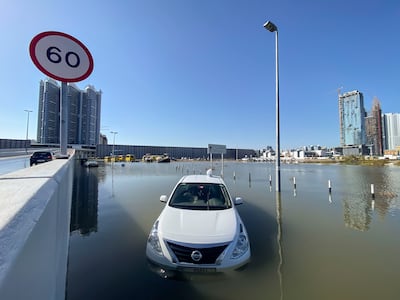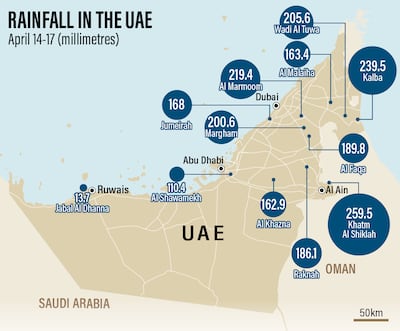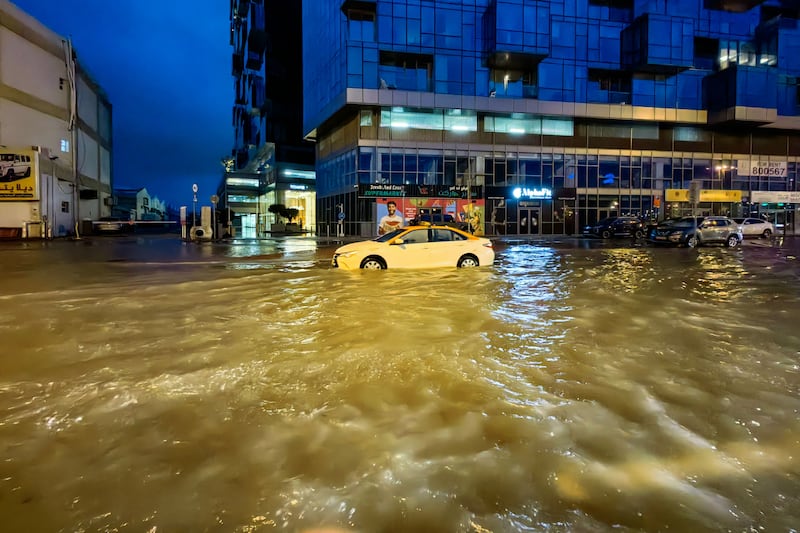UAE weather live: Emirates hit by severe storms
President Sheikh Mohamed has called for a quick response from authorities after the storms that caused havoc across the UAE this week.
His comments came after extreme weather in which the UAE was hit with more rain this week than it would normally expect to receive in more than a year, according to official figures.
Sheikh Mohamed expressed his appreciation for the awareness and responsibility shown by people during the adverse weather conditions, reported state news agency Wam.
He has requested that authorities quickly work on limiting the damage caused after the country witnessed its heaviest rainfall on record.
Sheikh Mohamed also asked that necessary support be provided to all families affected by the severe weather, ordering that they be moved to safe locations in co-operation with local authorities, Wam reported.
Sheikh Mohammed bin Rashid, Vice President and Ruler of Dubai, also commented on the effects of the extreme weather.
"Crises reveal the strength of countries and societies … and the natural climate crisis that we experienced showed great care, awareness, cohesion and love for every corner of the country from all its citizens and residents," he wrote on social media platform X.
"May God protect the UAE and its society, and perpetuate its glory, pride and safety."
The National Centre of Meteorology issued a weather map charting how much rain had fallen across every part of the Emirates.
Five areas received at least 200mm of rain in the period – double the country's typical annual rainfall.
The highest accumulation was 259.5mm in Khatam Al Shaklah in Al Ain, while 239mm of rain fell in Kalba, Sharjah.
The heavy rain, thunder and lightning caused chaos across the country, with an Emirati man dying during flash floods in Ras Al Khaimah on Tuesday.
The man, who was in his 70s, was killed when his vehicle was swept away by strong currents. Police said he had been trying to travel through a flooded wadi.

With widespread flooding across much of the country, the roads are still treacherous.
Remote learning will remain in place for the rest of the week at government schools, while private schools across the country will largely follow suit.
The Dubai government has also mandated that all affiliated entities will continue to work remotely on both Thursday and Friday.
Travel has been significantly affected, though the pressure on public services beginning to ease by Wednesday evening.
Flights were severely disrupted, with roads leading to Dubai International Airport remaining blocked and flooded.
Several passengers missed flights while many airlines cancelled or diverted services after the airport was forced to cease operations for 25 minutes on Tuesday evening.
Emirates airline suspended check-in for passengers departing from Dubai until 9am on Thursday, while Air Arabia announced that their Wednesday flights to the UAE had been cancelled or rescheduled.
Abu Dhabi’s Zayed International Airport saw 21 flights redirected from Dubai, 20 of which were passenger flights. The capital’s airport remained fully operational throughout the storm.
Transport links across Dubai were severely affected, with both the Dubai Metro and the Dubai Tram pausing operations amid widespread flooding.
The tram returned to normal service at about 1pm on Wednesday, while Dubai Metro stations began reopening shortly after 5pm.
Traffic was at a standstill on stretches of Dubai's Sheikh Zayed Road for much of the day and some motorists abandoned their vehicles on the motorway.
The National's Ramola Talwar Badam witnessed the disruption, noting that several exits, both Abu Dhabi and Dubai-bound, remained waterlogged.

She said some motorists left flood-damaged cars and were walking on the motorway to escape the growing queues.
Police were sent to the area in an attempt to manage traffic flow and ensure public safety.
After the storm, many people took to social media to speculate that the country’s cloud-seeding programme – a process that attempts to coax more rain from a cloud – was responsible for the deluge.
But the country’s weather bureau said no such missions had taken place.
Cloud seeding did not cause storms
A representative for the NCM confirmed to The National on Wednesday that its seeding planes had not approached the storm.
“The NCM didn't conduct any seeding operations during this event,” it said in a statement.
“One of the basic principles of cloud seeding is that you have to target clouds in its early stage before it rains. If you have a severe thunderstorm situation, then it is too late to conduct any seeding operation.
“We take the safety of our people, pilots and aircraft very seriously. NCM doesn't conduct cloud seeding operations during extreme weather events.”
Some reports on Tuesday attributed comments to an NCM forecaster stating seeding had taken place.
But the bureau said planes had been in the air in the days running up to the storm but they had only “taken samples” and had not been seeding clouds.
The NCM oversees the seeding programme and has previously stated several times that it is too dangerous to use seeding planes during severe weather.
It has also previously stated that, during bouts of unsettled weather when seeding does take place, the process would not create thunderstorms.
“Some say we are responsible for storms. We are not responsible for this,” an NCM forecaster previously told The National.
“Aircraft do not go inside storm clouds if they are strong or dangerous. All we do is try to strengthen some clouds.”





